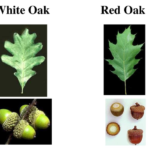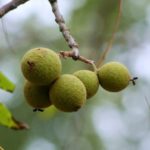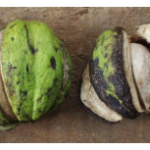
Nuts account for some of nature’s most nutritious bounty. For both Native Americans and early colonists, foraging for nuts, also called nutting, was a large part of preparing for the winter months. Nuts are compact, easy to store and are rich sources of protein, dietary fiber, vitamins and antioxidants. Scattered across the forest floor in the fall, tree nuts are easy to study this time of year.
Although foraging for nuts is prohibited within Preservation Parks properties, identifying the nuts you encounter enhances time spent in the woods. If you aim to find a place to gather nuts, try Ohio State Parks or in your own neighborhood. Below are some of the common edible nuts found here in Delaware County.
ACORNS: The seeds from oak trees are plentiful this time of year. Acorn kernels provide protein and energy-rich carbohydrates. The challenge is in preparing them. Raw acorns tastes very bitter because they are filled with tannins. To avoid this bitter, face-puckering experience, simply leach out the tannins with water. Boil the kernels whole for 15 minutes, pour the brown water off, add fresh water, and boil for another 15 minutes. Repeat this cycle until the water is mostly clear.
 White-oak acorns may require only one or two changes of water, while red-oak nuts usually need many changes. By the way, that tannin-rich brown water is a soothing topical wash for insect bites, stings, sunburn and rashes.
White-oak acorns may require only one or two changes of water, while red-oak nuts usually need many changes. By the way, that tannin-rich brown water is a soothing topical wash for insect bites, stings, sunburn and rashes.
After the leaching process, you can use the blanched acorns in all kinds of recipes, including salads, soups and stews. You can even use them to make acorn butter and coffee!
BEECHNUTS:

Beech trees produces a tasty protein-rich nut similar to a walnut. Beech trees produce nut casings each year, but only have full nuts every three years or so. If there is an abundant beech tree nearby, you’d better hurry to gather these nuts before the squirrels and raccoons beat you to it. Beechnuts spoil quickly, so dry roast them soon after harvesting. To prepare beechnuts, roast them in the shell in full sun (if you have a squirrel-proof spot) or in a slow oven. Then place the nuts between two cotton towels and rub them to remove the shells. Beechnuts also can be cold pressed to extract the oil.
BLACK WALNUTS: Black walnut trees are prized for their rich dark wood and for their tasty nuts. But getting to the delicious nutmeat presents challenges. You will have stiff competition from four-legged creatures who are well equipped to gnaw through the walnut’s hard shells. You’ll have to smash your way in with a hammer, combining shell fragments with edible nut pieces in the process. Plus, the brown juice inside the black walnut shell will stain anything with which it comes in contact.

Walnut lovers have tried various methods of getting to the meat, from running them over with their cars to wearing heavy boots and stomping the husks off with your feet. Another option is to wear rubber gloves and then cut and scrape the husks away with a knife. Once you have separated the meat from the shells, let the meat dry in full sun.
SHAGBARK HICKORY NUTS: Hickory nuts are easier to crack than walnuts, but you still will need a hammer. The nut is encased in a thick, green husk that separates in four parts at the base when it is ripe. The nut meat has a mild taste and is dense with nutrients, healthy oils and antioxidants.








